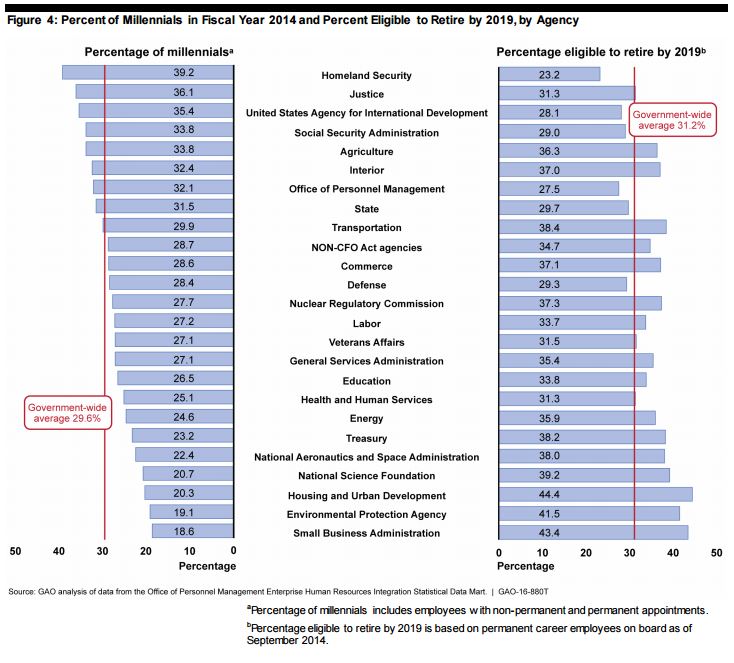
New proposals needed to break gov’t hiring status quo, Senate, agencies say
With 31 percent of the federal workforce eligible to retire by September 2019, most agencies acknowledge they're racing against the clock to recruit and hire the...
With 31 percent of the federal workforce eligible to retire by September 2019, most agencies acknowledge they’re racing against the clock to recruit and hire the next generation of federal employees.
It’s not for lack of trying, the Senate Homeland Security and Governmental Affairs Subcommittee on Regulatory Affairs and Federal Management acknowledged during a Sept. 29 hearing on hiring millennials in government.
The White House launched the President’s Hiring Reform initiative in 2010. In 2011, the Office of Personnel Management started separate initiatives to help agencies hire more veterans and students. In 2015, OPM created the Recruitment, Engagement, Diversity and Inclusion strategy.
And this year, OPM began the Hiring Excellence campaign to better educate hiring managers and human resources specialists about the existing authorities they have to bring in new talent.
But persistent, repeat challenges are preventing agency chief human capital officers from hiring new talent — particularly candidates under age 40— more quickly. And removing those barriers will likely take many debate-filled proposals to shift the status quo.
“It seems like every year or two there’s a new initiative,” Subcommittee Chairman James Lankford (R-Okla.) said. “I understand some of those are for different people groups as well, and those are all strategic areas. My challenge is … when we come back to the data … in 2013, it took about 90 days to do a hiring. In 2014, it took 94.4 days to do a federal hire. In 2015, it now takes 99.6 days. Our length of time to actually get there is getting longer.”
On average, it takes about 100 days to hire a new employee to government. OPM wants to bring that time-to-hire number down to about 80 days, said Mark Reinhold, associate director for employee services and chief human capital officer at the agency.
Average hiring times differ at various agencies. At the Homeland Security Department, it takes roughly 125 days to fill a position, the agency’s chief human capital officer, Angela Bailey, said. That number has decreased in recent years, as DHS has tried new initiatives and used direct hiring authorities.
“There’s some good initiatives that are going [on], and it’s obvious there’s an attention to this, but what’s the barrier?” Lankford said. “What can we do to be able to break through that?”
Agency human capital leaders say there’s a wide array of challenges that prevent them from easily recruiting, hiring and retaining the best and brightest.
The General Schedule Classification System, for example, needs a major update, the Government Accountability Office said.
“It was designed for a workforce … of a different time,” Robert Goldenkoff, director of strategic issues at GAO, said. “Things have changed. The skills that are required for a federal job have changed. We have a need for many more advanced skills than existed just even in the last 10 years. All those things need to be re-examined.”
The subcommittee agreed. But a project like that will need congressional input, including changes to the statute and Title 5 of the U.S. Code.
The President proposed a commission to look into General Schedule reform, but it hasn’t yet gotten off the ground, Goldenkoff said.
“That’s a big, big job, and that’s why it’s not getting done,” Sen. Heidi Heitkamp (D-N.D.), the subcommittee’s ranking member, said. “If this [was] easy it would be done.”
Agencies also have too many hiring authorities, Bailey said. They used 20 out 105 different hiring authorities to make 178,000, or 90 percent, of new hires in 2014, according to GAO. But they used many more — 85 separate hiring codes — to fill just 18,000 appointments during the same year.
The human resources community also needs more training and resources.
“We really actually need to start growing out, through what I’ll call an HR academy,” Bailey said. “I would love … to see OPM get back in the business of actually providing HR training. So whenever I was coming up in my 20s and I was an Army intern, you went to OPM and you got trained. It was considered world-class training, and people actually recognized that and cared about that.”
‘Are you ready?’
The pressure is on for agencies to whittle down hiring times and recruit young talent because the federal workforce is aging.
“If 30 percent of the workforce that’s working today is not working — everybody retires when they can retire — are you ready for that?” Heitkamp said. “That’s a huge, huge challenge.”
Millennials, or people at or under the age of 39, made up 29.6 percent of the federal workforce in fiscal 2014, GAO said.

Best practices to recruit and hire millennials exist in pockets throughout the government, Reinhold said.
DHS, for example, hired 370 new cybersecurity and technology professionals during a two-day job fair over the summer. The department made on-the-spot job offers and helped prospective employees through the clearance process the day of the fair, Bailey said.
Millennials make up the highest proportion of the DHS workforce than any other agency.
Next steps
As both subcommittee leaders stressed, the conversation isn’t over. They made an open call for ideas and new proposals to improve the federal hiring process, even suggesting that the witnesses continue to submit those ideas if and when they leave the current administration.
“As you encounter different groups, different entities, that they get together and they think through these issues and they make proposals and ideas, we are opening to seeing them and reading them and having those conversations,” Lankford said. “It doesn’t have to be in an open hearing like this. We’re glad to be able to go through those documents and to be able to determine what are good solutions and directions to be able to go.”
And with the presidential transition coming up, Heitkamp suggested that now might be a good time to start thinking about new solutions to some of these big problems.
“All of this rigidity leads to a diminished employment pool,” she said. “We need to figure that out and we need to really understand what it is that the new worker wants in the workplace, and we need to deliver that.”
Copyright © 2025 Federal News Network. All rights reserved. This website is not intended for users located within the European Economic Area.
Nicole Ogrysko is a reporter for Federal News Network focusing on the federal workforce and federal pay and benefits.
Follow @nogryskoWFED






